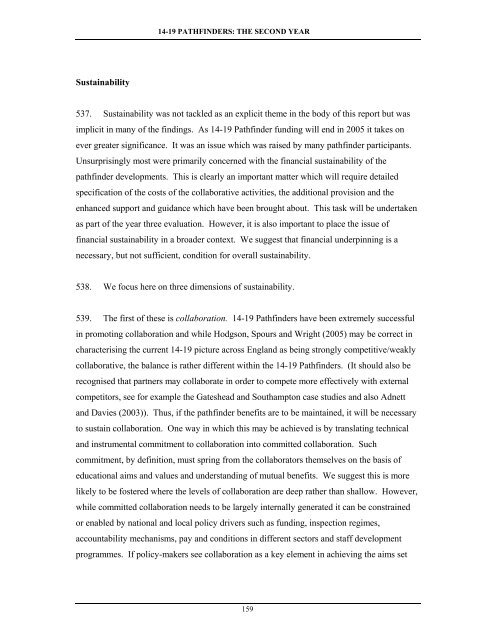Collaborative Approaches to 14-19 Provision - Communities and ...
Collaborative Approaches to 14-19 Provision - Communities and ...
Collaborative Approaches to 14-19 Provision - Communities and ...
- No tags were found...
Create successful ePaper yourself
Turn your PDF publications into a flip-book with our unique Google optimized e-Paper software.
<strong>14</strong>-<strong>19</strong> PATHFINDERS: THE SECOND YEARSustainability537. Sustainability was not tackled as an explicit theme in the body of this report but wasimplicit in many of the findings. As <strong>14</strong>-<strong>19</strong> Pathfinder funding will end in 2005 it takes onever greater significance. It was an issue which was raised by many pathfinder participants.Unsurprisingly most were primarily concerned with the financial sustainability of thepathfinder developments. This is clearly an important matter which will require detailedspecification of the costs of the collaborative activities, the additional provision <strong>and</strong> theenhanced support <strong>and</strong> guidance which have been brought about. This task will be undertakenas part of the year three evaluation. However, it is also important <strong>to</strong> place the issue offinancial sustainability in a broader context. We suggest that financial underpinning is anecessary, but not sufficient, condition for overall sustainability.538. We focus here on three dimensions of sustainability.539. The first of these is collaboration. <strong>14</strong>-<strong>19</strong> Pathfinders have been extremely successfulin promoting collaboration <strong>and</strong> while Hodgson, Spours <strong>and</strong> Wright (2005) may be correct incharacterising the current <strong>14</strong>-<strong>19</strong> picture across Engl<strong>and</strong> as being strongly competitive/weaklycollaborative, the balance is rather different within the <strong>14</strong>-<strong>19</strong> Pathfinders. (It should also berecognised that partners may collaborate in order <strong>to</strong> compete more effectively with externalcompeti<strong>to</strong>rs, see for example the Gateshead <strong>and</strong> Southamp<strong>to</strong>n case studies <strong>and</strong> also Adnett<strong>and</strong> Davies (2003)). Thus, if the pathfinder benefits are <strong>to</strong> be maintained, it will be necessary<strong>to</strong> sustain collaboration. One way in which this may be achieved is by translating technical<strong>and</strong> instrumental commitment <strong>to</strong> collaboration in<strong>to</strong> committed collaboration. Suchcommitment, by definition, must spring from the collabora<strong>to</strong>rs themselves on the basis ofeducational aims <strong>and</strong> values <strong>and</strong> underst<strong>and</strong>ing of mutual benefits. We suggest this is morelikely <strong>to</strong> be fostered where the levels of collaboration are deep rather than shallow. However,while committed collaboration needs <strong>to</strong> be largely internally generated it can be constrainedor enabled by national <strong>and</strong> local policy drivers such as funding, inspection regimes,accountability mechanisms, pay <strong>and</strong> conditions in different sec<strong>to</strong>rs <strong>and</strong> staff developmentprogrammes. If policy-makers see collaboration as a key element in achieving the aims set159
















